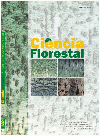
|
Ciência Florestal
Centro de Pesquisas Florestais - CEPEF, Departamento de Ciências Florestais - DCFL, Programa de Pós Graduação em Engenharia Florestal - PPGEF
ISSN: 0103-9954
EISSN: 0103-9954
Vol. 29, No. 1, 2019, pp. 14-26
|
 Bioline Code: cf19002
Bioline Code: cf19002
Full paper language: Portuguese
Document type: Research Article
Document available free of charge
|
|
|
Ciência Florestal, Vol. 29, No. 1, 2019, pp. 14-26
| en |
Litter removal impact on an edaphic arthropod community in abandoned Corymbiacitriodora  plantations plantations
Camara, Rodrigo; Silva, Vinicius Duncan; Correia, Maria Elizabeth Fernandes & Villela, Dora Maria
Abstract
Manipulation experiments can contribute to understand the ecological role of litter in forest ecosystems. However,
there are few studies of this nature. We evaluated the effects of the litter layer removal (RS) on the soil arthropod
community in two abandoned plantations of Corymbia citriodora at different stages of the Atlantic Rainforest natural
regeneration. Pitfall traps were randomly installed in plots (5 x 20 m) of RS and control (CT) in a 19-year old
plantation (P19: less advanced stage of natural regeneration of Atlantic Rainforest species; higher contribution of
eucalypt in litterfall) and a 42-year old plantation (P42: more advanced stage of regeneration; higher contribution
of native species in litterfall), in rainy season and dry season at ‘Uniуo Biological Reserve’, RJ state, Brazil. RS
inhibited the abundance of the most taxonomic groups, both in P19 and P42. In general, Diptera, Poduromorpha,
Pseudoscorpionida, Symphypleona, and larvae of Coleoptera were the most negatively impacted groups by RS. In
contrast, RS favored some other groups, principally Entomobryomorpha and Formicidae. Total richness, evenness
and diversity were lower in RS in both plantations. However, this negative effect was stronger in the P19, where RS
also decreased total abundance and average richness. The higher canopy closure probable minimized the negative
impact of RS on the soil arthropods in P42.
Keywords
Eucalyptus; Soil fauna; Atlantic Rainforest; Nutrient cycling
|
| |
| pt |
Impacto da remoчуo de serapilheira sobre a comunidade de artrѓpodes edсficos em plantios abandonados de Corymbiacitriodora 
Camara, Rodrigo; Silva, Vinicius Duncan; Correia, Maria Elizabeth Fernandes & Villela, Dora Maria
Resumo
Experimentos de manipulaчуo podem contribuir para a compreensуo do papel ecolѓgico da serapilheira em ecossistemas
florestais. No entanto, hс poucos estudos desta natureza. Os efeitos da remoчуo da camada de serapilheira (RS)
foram avaliados sobre a comunidade de artrѓpodes do solo em dois plantios abandonados de Corymbia citriodora,
em diferentes estсgios de regeneraчуo natural de espщcies nativas de Mata Atlтntica. Armadilhas de queda foram
instaladas aleatoriamente em 5 parcelas (5 x 20 m) de RS e controle (CT), no plantio com 19 anos de idade (P19:
estсgio menos avanчado; maior participaчуo da serapilheira de eucalipto) e plantio com 42 anos (P42: estсgio mais
avanчado de regeneraчуo; maior participaчуo da serapilheira de espщcies nativas), nas estaчѕes chuvosa e seca, na
Reserva Biolѓgica Uniуo, RJ, Brasil. A maioria dos grupos taxonєmicos apresentou inibiчуo da abundтncia com
a RS, no P19 e P42. De uma maneira geral, Diptera, Poduromorpha, Pseudoscorpionida, Symphypleona e larvas
de Coleoptera foram os principais grupos impactados negativamente pela RS. Por outro lado, alguns grupos foram
favorecidos pela RS, principalmente Entomobryomorpha e Formicidae. A RS diminuiu a riqueza total, uniformidade
e diversidade de artrѓpodes edсficos em ambos os plantios. Contudo, este efeito negativo foi mais importante no
P19, no qual tambщm ocorreu a diminuiчуo da abundтncia total e riqueza mщdia. O maior fechamento do dossel
provavelmente minimizou o impacto negativo da RS sobre os artrѓpodes edсficos no P42.
Palavras-chave
Eucalipto; Fauna do solo; Mata Atlтntica; Ciclagem de nutrientes
|
| |
© Copyright 2019 - Ciência Florestal
Alternative site location: http://cascavel.ufsm.br/revistas/ojs-2.2.2/index.php/cienciaflorestal/index
|
|
